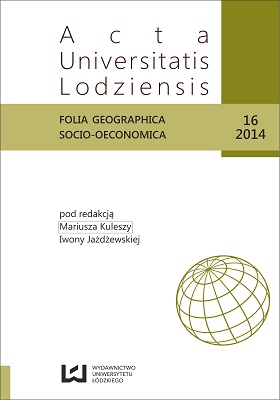Zastosowanie narzędzi GIS do analizy planu miasta w morfologii miast
DOI:
https://doi.org/10.18778/1508-1117.16.11Słowa kluczowe:
GIS, ArcGIS, morfologia miast w ujęciu Conzena, analiza planu miastaAbstrakt
W artykule w sposób praktyczny przedstawiono możliwości zastosowania narzędzi GIS podczas przeprowadzania analizy planu miasta pod kątem morfologicznym. Krok po kroku scharakteryzowano poszczególne etapy takiej analizy, wskazując na korzyści, jakie niesie za sobą wykorzystanie tychże narzędzi. Zwrócono również uwagę na mogące pojawić się trudności i pokazano sposoby minimalizowania ich wpływu na przebieg badań.
Bibliografia
Baranowska M., 2007, Koncepcja zjawiska Fringe Belt, [w:] Jażdżewska I. (red.), Polska geografia osadnictwa, dotychczasowy dorobek, program badań, XX Konwersatorium Wiedzy o Mieście, Wydawnictwo Uniwersytetu Łódzkiego, Łódź, s. 177‒ 183.
Google Scholar
Baranowska M., 2009, Fringe belt – geneza zjawiska i rozwój koncepcji w literaturze badawczej, [w:] Kulesza M. (red.), Geografia historyczna jako determinanta rozwoju nauk humanistycznych, Legnica‒Łódź, s. 255‒266
Google Scholar
Chmielewska M., 2010, Koncepcje M.R.G. Conzena w badaniach przekształceń przestrzeni miejskiej miasta przemysłowego, [w:] Sitek S. (red.), „Stare i nowe” problemy badawcze w geografii społeczno-ekonomicznej, z. 1, PTG Oddział Katowicki, UŚ WNoZ, Sosnowiec, s. 15‒21.
Google Scholar
Chmielewska M., 2012a, Current changes in morphology of the city center of Katowice, [w:] „Acta Geographica Silesiana”, 11, WNoZ UŚ–ZPKWŚ, Sosnowiec‒Będzin, s. 5‒14.
Google Scholar
Chmielewska M., 2012b, Morfologiczne przekształcenia przestrzeni miejskiej Katowic, maszynopis pracy doktorskiej
Google Scholar
Conzen M.R.G., 1960, Alnwick, Northumberland. A Study in Townplan Analysis, The Institute of British Geographers, 27, London.
Google Scholar
DOI: https://doi.org/10.2307/621094
Conzen M.R.G., 1962, The Plan Analysis of an English City Center (Newcastle upon Tyne), [w:] Proceedings of the International Geographical Union Symposium in Urban Geography, „Lund Studies in Geography”, 24, Lund, s. 383‒414.
Google Scholar
Conzen M.R.G., 1966, Historical townscapes in Britain: a problem in applied geography, [w:] House J.W. (red.), Northern geographical essays in honour of G.H.J. Daysh, s. 56‒78.
Google Scholar
Conzen M.R.G., 1968, The Use of Town Plans in the Study of Urban History, [w:] Doys H.J. (red.), The Study of Urban History, London, s. 127‒130.
Google Scholar
Golachowski S., 1956, Głos w dyskusji nad genezą rozplanowania średniowiecznego Wrocławia, [w:] „Kwartalnik Architektury i Urbanistyki”, t. 1.
Google Scholar
Huang J., Lu X.X., Sellers J.M., 2007, A global comparative analysis of urban form: Applying spatial metrics and remote sensing, „Landscape and Urban Planning”, 82, s. 184‒197.
Google Scholar
DOI: https://doi.org/10.1016/j.landurbplan.2007.02.010
Koster E., 1998, Urban morphology and computers, „Urban Morphology”, 2, ISUF, s. 3‒7
Google Scholar
DOI: https://doi.org/10.51347/jum.v2i1.3876
Koster E., 2001, Urban Morphology. A Taste of a Form-oriented Approach to the History of Urban Development, PhD thesis, Gröningen University, Gröningen.
Google Scholar
Koter M., 1969, Geneza układu przestrzennego Łodzi przemysłowej, PWN, Warszawa
Google Scholar
Koter M., 1974, Fizjonomia, morfologia i morfogeneza miasta. Przegląd rozwoju oraz próba uściślenia pojęć, [w:] „Zeszyty Naukowe Uniwersytetu Łódzkiego”, seria II, z. 55.
Google Scholar
Koter M., 1994, Od fizjonomii do morfogenezy i morfologii porównawczej. Podstawowe zagadnienia teoretyczne morfologii miast, [w:] Koter M., Tkocz J. (red.), Zagadnienia geografii historycznej osadnictwa w Polsce, Materiały konferencyjne, Uniwersytet Mikołaja Kopernika, Uniwersytet Łódzki, Toruń–Łódź, s. 23‒32.
Google Scholar
Koter M., Kulesza M., 2008, Zastosowanie metod conzenowskich w polskich badaniach morfologii miast, [w:] Kulesza M. (red.), Czas i przestrzeń w naukach geograficznych. Wybrane problemy geografii historycznej, Wydawnictwo UŁ, Łódź, s. 257‒ 272.
Google Scholar
Kulesza M., 2001, Morfogeneza miast na obszarze Polski Środkowej w okresie przedrozbiorowym. Dawne województwa łęczyckie i sieradzkie, Wydawnictwo UŁ, Łódź.
Google Scholar
Larkham P.J., 1991, Urban Form, Urban Morphology and Urban Historical Geography, [w:] Larkham P.J., Jones A.N. (red.), A Glossary of Urban Form, „Historical Geography Research”, 26, Birmingham.
Google Scholar
Larkham P.J., 2006, The study of urban form in Great Britain, „Urban Morphology”, 10(2), s. 117‒141.
Google Scholar
DOI: https://doi.org/10.51347/jum.v10i2.3930
Longley P.A. i in., 2006, GIS. Teoria i praktyka, PWN, Warszawa.
Google Scholar
Maltret J.-L., Zoller J., 1996, Simulation of Architectural and Urban Morphology, [w:] OEEPE Workshop on 3D-city models, Bonn
Google Scholar
Miszewska B., 1971, Analiza morfologiczna Opola, [w:] „Studia Społeczno-Ekonomiczne”, 2.
Google Scholar
Miszewska B., 1979, Elementy struktury morfologicznej Wrocławia, [w:] „Prace Instytutu Geograficznego Uniwersytetu Wrocławskiego”, ser. B, t. 3.
Google Scholar
Miszewska B., 2000, Rodzaje sukcesji funkcjonalnej w mieście na przykładzie Wrocławia, [w:] Słodczyk J. (red.), Społeczne, gospodarcze i przestrzenne przeobrażenia miast, Opole, s. 293–305.
Google Scholar
Moudon A.V., 1997, Urban morphology as an emerging interdisciplinary Fidel, „Urban Morphology”, 1, ISUF, s. 3‒10.
Google Scholar
DOI: https://doi.org/10.51347/jum.v1i1.4047
Moudon A.V., 1998, The changing morphology of suburban neighbourhoods, [w:] Petruciolli E. (red.), Typological Process and Design Theory, Cambridge, s. 141‒157.
Google Scholar
Muratori S., 1959, Studi per una operante storia Urbana di Venezia, Instituto Poligraphico dello Stato, Roma.
Google Scholar
Muratori S., 1963, Architettura e civilta in crisi. Centro Studi di Staria Urbanistica, Roma
Google Scholar
Pinho P., Oliveira V., 2009, Cartographic analysis in urban morphology, [w:] „Environment and Planning B: Planning and Design”, 36, s. 107‒127.
Google Scholar
DOI: https://doi.org/10.1068/b34035
Schütz F.X., 2008, Zum Regensburger und Kölner Stadtgrundriss. Ein GIS-gestützte Unetrsuchung, „Regensburger Studien”, 14, Regensburg.
Google Scholar
Szczepańska J. i in., 2002, Zaczarowany świat kartografii, cz. I, Bractwo Gospodarcze Związku Górnośląskiego, Pszczyna.
Google Scholar
Urbański J., 1997, Zrozumieć GIS. Analiza informacji przestrzennej, PWN, Warszawa
Google Scholar
Whitehand J.W.R., 1987, Urban Morphology, [w:] Pacione M. (red.), Historical Geography. Progress and Prospect, London.
Google Scholar
Whitehand J.W.R., 2001, British urban morphology: the Conzenian tradition, [w:] „Urban Morphology”, 5(2), ISUF, s. 103‒109.
Google Scholar
DOI: https://doi.org/10.51347/jum.v5i2.3896
Zagożdżon A., 1971, Morfologia osiedli woj. opolskiego, [w:] Struktury i procesy osadnicze, PWN, Wrocław‒Opole, s. 331‒372.
Google Scholar
Pobrania
Opublikowane
Jak cytować
Numer
Dział
Licencja

Utwór dostępny jest na licencji Creative Commons Uznanie autorstwa – Użycie niekomercyjne – Bez utworów zależnych 4.0 Międzynarodowe.








